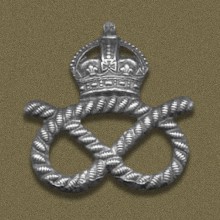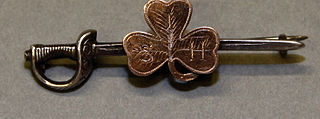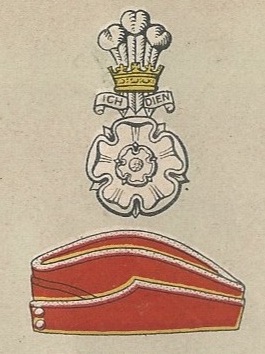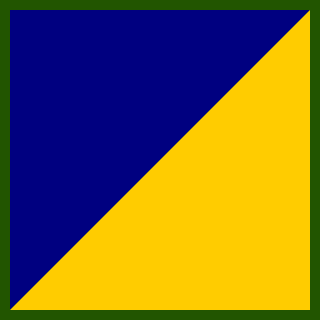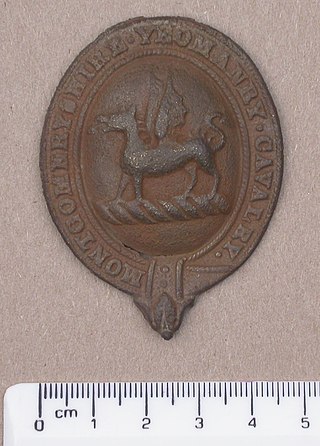 |
| British Army lists |
|---|
| French Revolutionary and Napoleonic Wars |
| Victorian era |
| First World War |
| Second World War |
| Regiments |
| Officers |
| Other |
Following a string of defeats during Black Week in early December 1899, the British government realised that it would need more troops than just the Regular army to fight the Second Boer War, particularly mounted troops. On 13 December, the War Office decided to allow volunteer forces to serve in the field, and a Royal Warrant was issued on 24 December that officially created the Imperial Yeomanry (IY). This was organised as service companies of 121 officers and men enlisted for one year. Existing Yeomanry and fresh volunteers quickly filled the new force, which was equipped to operate as Mounted infantry. The companies were organised into battalions, often of companies from the same region. [1] [2] [3] [4] [5] [6] [7] Besides the companies raised directly by the Yeomanry Cavalry regiments, a number of companies and battalions were formed by enthusiasts. These included Paget's Horse, the Sharpshooters and the Roughriders, all recruited in London, [2] [8] and the specialists of Lovat's Scouts. [9] On arrival in South Africa, the companies were frequently used piecemeal in various ad hoc columns, and some of the battalions (for example 12th Battalion [6] ) never operated as formed units. At the end of their year of service, recruitment of a Second Contingent was authorised in January to replace the time-expired men in the original units and to form new units. A Third Contingent was recruited from late 1901 onwards, largely as new units, while the existing battalions were consolidated. [10]
Contents
The following units of Imperial Yeomanry were formed between 1990 and 1902: [11] [12] [13] [14] [15]
| Company | Sponsor | Assigned battalion 1900 | Assigned battalion 1901 | Assigned battalion 1902 |
|---|---|---|---|---|
| First Contingent | ||||
| 1st (Wiltshire) | Royal Wiltshire Yeomanry | 1st | 1st | 1st |
| 2nd (Wiltshire) | Royal Wiltshire Yeomanry | 1st | 1st | 1st |
| 3rd (Gloucestershire) | Royal Gloucestershire Hussars | 1st | 1st | 1st |
| 4th (Glamorgan) | Windham Wyndham-Quin, MP | 1st | 1st | 1st |
| 5th (Warwickshire) | Warwickshire Yeomanry | 2nd | 2nd | 2nd |
| 6th (Staffordshire) | Staffordshire Yeomanry | 4th | 4th | 4th |
| 7th (Leicestershire) | Leicestershire Yeomanry | 4th | 4th | 4th |
| 8th (Derbyshire) | Derbyshire Yeomanry | 4th | 4th | 4th |
| 9th (Yorkshire (Doncaster)) | Yorkshire Hussars | 3rd | 3rd | 3rd |
| 10th (Sherwood Rangers) | Sherwood Rangers Yeomanry | 3rd | 3rd | 3rd |
| 11th (Yorkshire Dragoons) | Yorkshire Dragoons | 3rd | 3rd | 3rd |
| 12th (South Nottinghamshire) | South Nottinghamshire Hussars | 3rd | 3rd | 3rd |
| 13th (Shropshire) | Shropshire Yeomanry | 5th | 5th | 5th |
| 14th (Northumberland) | Northumberland Hussars | 5th | 5th | 5th |
| 15th (Northumberland) | Northumberland Hussars | 5th | 5th | 5th |
| 16th (Worcestershire) | Worcestershire Yeomanry | 5th | 5th | 5th |
| 17th (Ayrshire and Lanarkshire) | Ayrshire Yeomanry Lanarkshire Yeomanry | 6th (Scottish) | 6th (Scottish) | |
| 18th (Queen's Own Royal Glasgow and Lower Ward of Lanark) | Queen's Own Royal Glasgow and Lower Ward of Lanarkshire Yeomanry | 6th (Scottish) | 6th (Scottish) | |
| 19th (Lothians and Berwickshire) | Lothians and Berwickshire Yeomanry | 6th (Scottish) | 6th (Scottish) | |
| 20th (Fife and Forfarshire Light Horse) | 1st Fifeshire Mounted Rifles 1st Forfarshire Light Horse Volunteers | 6th (Scottish) | 6th (Scottish) | |
| 21st (Cheshire) | Cheshire Yeomanry | 2nd | 2nd | 2nd |
| 22nd (Cheshire) | Cheshire Yeomanry | 2nd | 2nd | 2nd |
| 23rd (Lancashire) | Duke of Lancaster's Own Yeomanry | 8th | 8th | 8th |
| 24th (Westmorland and Cumberland) | Westmorland and Cumberland Yeomanry | 8th | 8th | 8th |
| 25th (West Somerset) | West Somerset Yeomanry | 7th | 7th | 7th |
| 26th (Dorsetshire) | Dorsetshire Yeomanry | 7th | 7th | 7th |
| 27th (Devonshire) | Royal 1st Devon Yeomanry | 7th | 7th | 7th |
| 28th (Bedfordshire) (Compton's Horse) | Lord Alwyne Compton | 4th | 4th | 4th |
| 29th (Denbighshire) | Denbighshire Hussars | 9th (Welsh) | 9th (Welsh) | 9th (Welsh) |
| 30th (Pembrokeshire) | Pembroke Yeomanry | 9th (Welsh) | 9th (Welsh) | 9th (Welsh) |
| 31st (Montgomeryshire) | Montgomeryshire Yeomanry | 9th (Welsh) | 9th (Welsh) | 9th (Welsh) |
| 32nd (Lancashire) | Duke of Lancaster's Own Yeomanry Lancashire Hussars | 2nd | 2nd | 2nd |
| 33rd (East Kent) | Royal East Kent Yeomanry | 11th | 11th | 11th |
| 34th (Middlesex) | Middlesex Yeomanry | 11th | 11th | |
| 35th (Middlesex) | Middlesex Yeomanry | 11th | 11th | |
| 36th (West Kent) | West Kent Yeomanry | 11th | 11th | 11th |
| 37th (Buckinghamshire) | Royal Bucks Hussars | 10th | 10th | |
| 38th (High Wycombe) | Royal Bucks Hussars | 10th | 10th | |
| 39th (Berkshire) | Berkshire Yeomanry | 10th | 10th | |
| 40th (Oxfordshire) | Queen's Own Oxfordshire Hussars | 10th | 10th | |
| 41st (Hampshire) | Hampshire Carabiniers | 12th [6] | ?Independent | 4th |
| 42nd (Hertfordshire) [6] | Hertfordshire Yeomanry | 12th | ?Independent | |
| 43rd (Suffolk) [3] | Loyal Suffolk Hussars | 12th | ?Independent | |
| 44th (Suffolk) [3] | Loyal Suffolk Hussars | 12th | ?Independent | |
| 45th (Dublin Hunt) | Earl of Longford | 13th (Irish) | 13th (Irish) | |
| 46th (1st Belfast) | 13th (Irish) | 13th (Irish) | ||
| 47th (Duke of Cambridge's Own) | Earl of Donoughmore | 13th (Irish) | 13th (Irish) | |
| 48th (North Somerset) | North Somerset Yeomanry | 7th | 7th | 7th |
| 49th (Montgomeryshire) | Montgomeryshire Yeomanry | 9th (Welsh) | 9th (Welsh) | 9th (Welsh) |
| 50th (Hampshire) | Hampshire Carabiniers | 17th | 17th | |
| 51st (Paget's Horse) [8] | George Paget | 19th (Paget's Horse) [8] | 19th (Paget's Horse) | |
| 52nd (Paget's Horse) [8] | George Paget | 19th (Paget's Horse) | 19th (Paget's Horse) | |
| 53rd (East Kent) | Royal East Kent Yeomanry | 14th | 14th | 11th |
| 54th (2nd Belfast) | 13th (Irish) | 13th (Irish) | ||
| 55th (Northumberland) | Northumberland Hussars | 14th | 14th | 5th |
| 56th (Buckinghamshire) | Royal Bucks Hussars | 15th | 15th | |
| 57th (Buckinghamshire) | Royal Bucks Hussars | 15th | 15th | |
| 58th (Berkshire) | Berkshire Yeomanry | 15th | 15th | |
| 59th (Oxfordshire) | Queen's Own Oxfordshire Yeomanry | 15th | 15th | |
| 60th (North Irish Horse (Belfast)) | 17th | 17th | ||
| 61st (South Irish Horse (Dublin)) | 17th | 17th | ||
| 62nd (Middlesex) | Middlesex Yeomanry | 14th | 14th | 11th |
| 63rd (Wiltshire) | Royal Wiltshire Yeomanry | 16th | 16th | 1st |
| 64th Company | Not formed | |||
| 65th (Leicestershire) | Leicestershire Yeomanry | 17th | 17th | |
| 66th (Yorkshire) | Yorkshire Dragoons Yorkshire Hussars | 16th | 16th | 3rd |
| 67th (Sharpshooters) | Earl of Dunraven | 18th (Sharpshooters) | 18th (Sharpshooters) | 18th (Sharpshooters) |
| 68th (Paget's Horse) [8] | George Paget | 19th (Paget's Horse) | 19th (Paget's Horse) | |
| 69th (Sussex) | Sussex Yeomanry | 14th | 14th | 7th |
| 70th (Scottish) (Sharpshooters) | Earl of Dunraven | 18th (Sharpshooters) | 18th (Sharpshooters) | 18th (Sharpshooters) |
| 71st (Sharpshooters) | Earl of Dunraven | 18th (Sharpshooters) | 18th (Sharpshooters) | 18th (Sharpshooters) |
| 72nd (Rough Riders) | Earl of Lathom | 20th (Rough Riders) | 20th (Rough Riders) | |
| 73rd (Paget's Horse) [8] | George Paget | 19th (Paget's Horse) | 19th (Paget's Horse) | |
| 74th (Dublin) | 16th | 16th | 8th | |
| 75th (Sharpshooters) | Earl of Dunraven | 18th (Sharpshooters) | 18th (Sharpshooters) | 18th (Sharpshooters) |
| 76th (Rough Riders) | Earl of Lathom | 20th (Rough Riders) | 20th (Rough Riders) | 22nd (Roughriders) |
| 77th (Manchester) | Lancashire Hussars | 8th | 8th | 4th |
| 78th (Rough Riders) | Earl of Lathom | 20th (Rough Riders) | 20th (Rough Riders) | 22nd (Roughriders) |
| 79th (Rough Riders) | Earl of Lathom | 20th (Rough Riders) | 20th (Rough Riders) | |
| Second Contingent | ||||
| 80th (Sharpshooters) | Earl of Dunraven | 21st (2nd Sharpshooters) | 21st (2nd Sharpshooters) | |
| 81st (Sharpshooters) | Earl of Dunraven | 21st (2nd Sharpshooters) | 21st (2nd Sharpshooters) | |
| 82nd (Sharpshooters) | Earl of Dunraven | 21st (2nd Sharpshooters) | 21st (2nd Sharpshooters) | |
| 83rd (Sharpshooters) | Earl of Dunraven | 21st (2nd Sharpshooters) | 21st (2nd Sharpshooters) | |
| 84th (Rough Riders) | Earl of Lathom | 22nd (Rough Riders) | ||
| 85th (Rough Riders) | Earl of Lathom | 22nd (Rough Riders) | ||
| 86th (Rough Riders) | Earl of Lathom | 22nd (Rough Riders) | 24th (Metropolitan Mounted Rifles) | |
| 87th (Rough Riders) | Earl of Lathom | 22nd (Rough Riders) | 24th (Metropolitan Mounted Rifles) | |
| 88th (Welsh Yeomanry) | Montgomeryshire Yeomanry | 9th (Welsh) | 9th (Welsh) | |
| 89th (Montgomeryshire) | Montgomeryshire Yeomanry | 9th (Welsh) | 9th (Welsh) | |
| 90th (Sharpshooters) | Earl of Dunraven | 23rd (3rd Sharpshooters) | 23rd (3rd Sharpshooters) | |
| 91st (Sharpshooters) | Earl of Dunraven | 23rd (3rd Sharpshooters) | ||
| 92nd (Sharpshooters) | Earl of Dunraven | 23rd (3rd Sharpshooters) | ||
| 93rd (Sharpshooters) | Earl of Dunraven | 23rd (3rd Sharpshooters) | 23rd (3rd Sharpshooters) | |
| 94th (Metropolitan Mounted Rifles) | 24th (Metropolitan Mounted Rifles) | 24th (Metropolitan Mounted Rifles) | ||
| 95th (Metropolitan Mounted Rifles) | 24th (Metropolitan Mounted Rifles) | |||
| 96th (Metropolitan Mounted Rifles) | 24th (Metropolitan Mounted Rifles) | 24th (Metropolitan Mounted Rifles) | ||
| 97th (Metropolitan Mounted Rifles) | 24th (Metropolitan Mounted Rifles) | |||
| 98th (North Riding of Yorkshire Volunteer Artillery) | 1st North Riding Artillery Volunteers | 3rd | ||
| 99th (Irish) | 8th | |||
| 100th (Northumberland) | Northumberland Hussars | 5th | 5th | |
| 101st (Northumberland) | Northumberland Hussars | 5th | 5th | |
| 102nd (Worcestershire) | Worcestershire Yeomanry | 5th | ||
| 103rd (Warwickshire) | Warwickshire Yeomanry | 2nd | 2nd | |
| 104th (Derbyshire) | Derbyshire Yeomanry | 4th | 4th | |
| 105th (Northumberland) | Northumberland Hussars | 5th | 8th | |
| 106th (Staffordshire) | Staffordshire Yeomanry | 4th | 4th | |
| 107th (Lanarkshire) | Lanarkshire Yeomanry | 6th (Scottish) | ||
| 108th (Royal Glasgow) | Queen's Own Royal Glasgow Yeomanry | 6th (Scottish) | ||
| 109th (Yorkshire Hussars) | Yorkshire Hussars | 3rd | 3rd | |
| 110th (Northumberland) | Northumberland Hussars | 2nd | 2nd | |
| 111th (Yorkshire Dragoons) | Yorkshire Dragoons | 3rd | 3rd | |
| 112th (Middlesex) | Middlesex Yeomanry | 11th | 11th | |
| 113th (Lovat's Scouts) | Lord Lovat | Independent | Independent | |
| 114th (Lovat's Scouts) | Lord Lovat | Independent | Independent | |
| Third Contingent | ||||
| 115th (Sharpshooters) | Earl of Dunraven | 25th (Sharpshooters) | ||
| 116th (Sharpshooters) | Earl of Dunraven | 25th (Sharpshooters) | ||
| 117th (Sharpshooters) | Earl of Dunraven | 25th (Sharpshooters) | ||
| 118th (Sharpshooters) | Earl of Dunraven | 25th (Sharpshooters) | ||
| 119th (Younghusband's Horse) | Lt-Col George Younghusband | 26th (Younghusband's Horse) | ||
| 120th (Younghusband's Horse) | Lt-Col George Younghusband | 26th (Younghusband's Horse) | ||
| 121st (Younghusband's Horse) | Lt-Col George Younghusband | 26th (Younghusband's Horse) | ||
| 122nd (Younghusband's Horse) | Lt-Col George Younghusband | 26th (Younghusband's Horse) | ||
| 123rd | 27th | |||
| 124th | 27th | |||
| 125th | 27th | |||
| 126th | 27th | |||
| 127th (Westminster Dragoons) | 28th (Westminster Dragoons) | |||
| 128th (Westminster Dragoons) | 28th (Westminster Dragoons) | |||
| 129th (Westminster Dragoons) | 28th (Westminster Dragoons) | |||
| 130th (Westminster Dragoons) | 28th (Westminster Dragoons) | |||
| 131st (Irish Horse) | 29th (Irish Horse) | |||
| 132nd (Irish Horse) | 29th (Irish Horse) | |||
| 133rd (Irish Horse) | 29th (Irish Horse) | |||
| 134th (Irish Horse) | 29th (Irish Horse) | |||
| 135th | 30th | |||
| 136th | 30th | |||
| 137th | 30th | |||
| 138th | 30th | |||
| 139th (Fincastle's Horse) | Lt-Col Viscount Fincastle | 31st (Fincastle's Horse) | ||
| 140th (Fincastle's Horse) | Lt-Col Viscount Fincastle | 31st (Fincastle's Horse) | ||
| 141st (Fincastle's Horse) | Lt-Col Viscount Fincastle | 31st (Fincastle's Horse) | ||
| 142nd (Fincastle's Horse) | Lt-Col Viscount Fincastle | 31st (Fincastle's Horse) | ||
| 143rd | 32nd | |||
| 144th | 32nd | |||
| 145th | 32nd | |||
| 146th | 32nd | |||
| 147th | 33rd | |||
| 148th | 33rd | |||
| 149th | 33rd | |||
| 150th | 33rd | |||
| 151st | 34th | |||
| 152nd | 34th | |||
| 153rd | 34th | |||
| 154th | 34th | |||
| 155th | 35th | |||
| 156th | 35th | |||
| 157th | 35th | |||
| 158th | 35th | |||
| 159th | 36th | |||
| 160th | 36th | |||
| 161st | 36th | |||
| 162nd | 36th | |||
| 163rd | 37th (Highland Horse) | |||
| 164th | 37th (Highland Horse) | |||
| 165th | 37th (Highland Horse) | |||
| 166th | 37th (Highland Horse) | |||
| 167th | 38th | |||
| 168th | 38th | |||
| 169th | 38th | |||
| 170th | 38th | |||
| 171st | 39th | |||
| 172nd | 39th | |||
| 173rd | 39th | |||
| 174th | 39th | |||
| 175th (Irish Horse) | 29th (Irish Horse) | |||
| 176th (Irish Horse) | 29th (Irish Horse) | |||
| 177th (Fincastle's Horse) | Lt-Col Viscount Fincastle | 31st (Fincastle's Horse) | ||
| 178th (Lovat's Scouts) | Lord Lovat | Independent | Independent | |
The mounted infantry experiment was considered a success and the existing Yeomanry regiments at home were reorganised and renamed as Imperial Yeomanry in 1901. Fresh regiments were also raised, often on the basis of returned veterans, such as the City of London Yeomanry (Rough Riders) and the 3rd County of London Yeomanry (Sharpshooters), the North Irish and South Irish Horse, and the Lovat Scouts. [13] [15] [16] [17]


